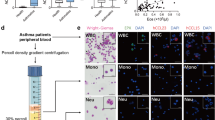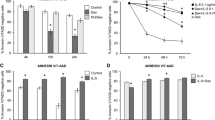Abstract
Leukotactin-1 (Lkn-1)/CCL15 is a CC chemokine that binds to the CCR1 and CCR3. Lkn-1 functions as an essential factor in the migration of monocytes, lymphocytes, and neutrophils. Although eosinophils express both receptors, the role of Lkn-1 in immature eosinophils remains to be elucidated. In this present study, we investigated the contribution of the CCR1-binding chemokines to chemotactic activity and in the differentiation in the human eosinophilic leukemia cell line EoL-1. Lkn-1 induced the stronger migration of EoL-1 cells than other CCR1-binding chemokines such as RANTES/CCL5, MIP-1α/CCL3 and HCC-4/CCL16. Lkn-1-induced chemotaxis was inhibited by pertussis toxin, an inhibitor of Gi/Go protein; U73122, an inhibitor of phospholipase C and rottlerin, an inhibitor of protein kinase C delta (PKCδ). Lkn-1 increased PKCδ activity, which was partially blocked by the pertussis toxin and U73122. Lkn-1 enhanced the butyric acid-induced differentiation via PKCδ after binding to the increased CCR1 because Lkn-1 caused EoL-1 cells to change morphologically into mature eosinophil-like cells. Likewise, Lkn-1 increased the expression of both eosinophil peroxidase (EPO) and the major basic protein (MBP). PKCδ activation due to Lkn-1 is involved in migration, as well as the butyric acid-induced differentiation. This finding contributes to an understanding of CC chemokines in eosinophil biology and to the development of novel therapies for the treatment of eosinophilic disorders. This study suggests the pivotal roles of Lkn-1 in the regulation of the movement and development of eosinophils.





Similar content being viewed by others
Abbreviations
- Lkn-1:
-
Leukotactin-1
- PKCδ:
-
Protein kinase C δ
- EPO:
-
Eosinophil peroxidase
- MBP:
-
Major basic protein
References
Baggiolini M, Dewald B, Moser B (1997) Human chemokines: an update. Annu Rev Immunol 15:675–705
Rollins BJ (1997) Chemokines. Blood 90:909–928
Youn BS, Zhang SM, Lee EK, Park DH, Broxmeyer HE, Murphy PM et al (1997) Molecular cloning of leukotactin-1: a novel human beta-chemokine, a chemoattractant for neutrophils, monocytes, and lymphocytes, and a potent agonist at CC chemokine receptors 1 and 3. J Immunol 159:5201–5205
Yu R, Kim CS, Kawada T, Kwon TW, Lim TH, Kim YW et al (2004) Involvement of leukotactin-1, a novel CC chemokine, in human atherosclerosis. Atherosclerosis 174:35–42
Jang SW, Kim YS, Lee YH, Ko J (2007) Role of human LZIP in differential activation of the NF-kappaB pathway that is induced by CCR1-dependent chemokines. J Cell Physiol 211:630–637
Pardigol A, Forssmann U, Zucht HD, Loetscher P, Schulz-Knappe P, Baggiolini M et al (1998) HCC-2, a human chemokine: gene structure, expression pattern, and biological activity. Proc Natl Acad Sci USA 95:6308–6313
Majka M, Janowska-Wieczorek A, Ratajczak J, Ehrenman K, Pietrzkowski Z, Kowalska MA et al (2001) Numerous growth factors, cytokines, and chemokines are secreted by human CD34(+) cells, myeloblasts, erythroblasts, and megakaryoblasts and regulate normal hematopoiesis in an autocrine/paracrine manner. Blood 97:3075–3085
Broxmeyer HE (2001) Regulation of hematopoiesis by chemokine family members. Int J Hematol 74:9–17
Han IS, Ra JS, Kim MW, Lee EA, Jun HY, Park SK et al (2003) Differentiation of CD34 + cells from human cord blood and murine bone marrow is suppressed by C6 beta-chemokines. Mol Cells 15:176–180
Kim WY, Broxmeyer HE, Han IS, Park DH, Lee KM, Vinay DS et al (2003) Effect of leukotactin-1 on the protection in vivo of myeloid progenitor cells against cytotoxic chemotherapeutics. J Hematother Stem Cell Res 12:107–113
Ko J, Kim IS, Jang SW, Lee YH, Shin SY, Min DS et al (2002) Leukotactin-1/CCL15-induced chemotaxis signaling through CCR1 in HOS cells. FEBS Lett 515:159–164
Wong CK, Ho CY, Lam SW, Zhang JP, Hjelm NM (1999) Differentiation of a human eosinophilic leukemic cell line, EoL-1: characterization by the expression of cytokine receptors, adhesion molecules, CD95 and eosinophilic cationic protein (ECP). Immunol Lett 68:317–323
Bankers-Fulbright JL, Kita H, Gleich GJ, O’Grady SM (2001) Regulation of human eosinophil NADPH oxidase activity: a central role for PKC delta. J Cell Physiol 189:306–315
Sano M, Leff AR, Myou S, Boetticher E, Meliton AY, Learoyd J et al (2005) Regulation of interleukin-5-induced beta2-integrin adhesion of human eosinophils by phosphoinositide 3-kinase. Am J Respir Cell Mol Biol 33:65–70
Kim IS, Ryang YS, Kim YS, Jang SW, Sung HJ, Lee YH et al (2003) Leukotactin-1-induced ERK activation is mediated via Gi/Go protein/PLC/PKC delta/Ras cascades in HOS cells. Life Sci 73:447–459
Rossi D, Zlotnik A (2000) The biology of chemokines and their receptors. Annu Rev Immunol 18:217–242
Ishihara K, Takahashi A, Kaneko M, Sugeno H, Hirasawa N, Hong J et al (2007) Differentiation of eosinophilic leukemia EoL-1 cells into eosinophils induced by histone deacetylase inhibitors. Life Sci 80:1213–1220
Cools J, DeAngelo DJ, Gotlib J, Stover EH, Legare RD, Cortes J et al (2003) A tyrosine kinase created by fusion of the PDGFRA and FIP1L1 genes as a therapeutic target of imatinib in idiopathic hypereosinophilic syndrome. N Engl J Med 348:1201–1214
Cools J, Quentmeier H, Huntly BJ, Marynen P, Griffin JD, Drexler HG et al (2004) The EOL-1 cell line as an in vitro model for the study of FIP1L1-PDGFRA-positive chronic eosinophilic leukemia. Blood 103:2802–2805
Pan J, Quintás-Cardama A, Manshouri T, Giles FJ, Lamb P, Tefferi A et al (2007) The novel tyrosine kinase inhibitor EXEL-0862 induces apoptosis in human FIP1L1-PDGFR-alpha-expressing cells through caspase-3-mediated cleavage of Mcl-1. Leukemia 21:1395–1404
Acknowledgement
This work was supported by the Korea Research Foundation Grant funded by the Korean Government (MOEHRD) (KRF-2007-331-E00028).
Author information
Authors and Affiliations
Corresponding author
Rights and permissions
About this article
Cite this article
Lee, JS., Kim, I.S. Leukotactin-1/CCL15 induces cell migration and differentiation of human eosinophilic leukemia EoL-1 cells through PKCδ activation. Mol Biol Rep 37, 2149–2156 (2010). https://doi.org/10.1007/s11033-009-9687-z
Received:
Accepted:
Published:
Issue Date:
DOI: https://doi.org/10.1007/s11033-009-9687-z




